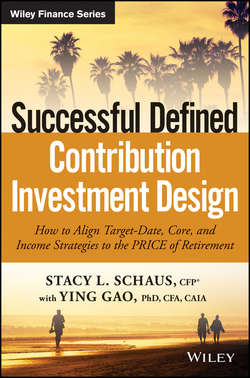Читать книгу Successful Defined Contribution Investment Design - Gao Ying - Страница 7
На сайте Литреса книга снята с продажи.
Introduction
ОглавлениеToday, workers around the globe are increasingly dependent on defined contribution plans to reach their retirement income goals. In the United States, fewer than one in five workers have access to a traditional defined benefit pension program. To retire financially secure, workers need well-designed defined contribution (DC) plans – as most will rely on such plans for at least a third of retirement income. Those who have access to a well-designed plan and are contributing at a sufficient level are likely to succeed. Unfortunately, not all workers are offered a DC plan.. and plans that are offered may have a less-than-optimal design.
As of 2015, we estimate that only about half of U.S. workers have access to a DC plan; in particular, people working part-time or for small employers often lack plan access. Some countries such as the United Kingdom and Australia have addressed DC plan availability by mandating that employers must offer and enroll employees into such programs. At this writing, we anticipate retirement plan availability will increase in the United States as multiple states and possibly the federal government will roll out compulsory programs or regulatory change to ease the burden of offering plans.
As plans become increasingly available, our hope is they offer an investment structure that places participants on a path to success.
This book is designed to assist plan sponsors and providers to structure investment menus that help participants meet their retirement goals. Our earlier book, Designing Successful Target-Date Strategies for Defined Contribution Plans: Putting Participants on the Optimal Glide Path (2010), provided a framework for understanding the growing role DC plans have come to play for Americans planning for and transitioning into and through retirement. In that volume, we reviewed the origins of DC plans with a focus on building custom target-date strategies, an innovation that is now widely adopted, particularly within the largest U.S. plans. Our earlier book was a resource that helped plan sponsors and their consultants as they considered how to create their own custom target retirement-date strategies. It was written at a time when DC plans were experiencing significant growth in both prevalence and assets.
In the intervening years, the trends we identified have accelerated. Global DC assets in seven major markets (representing more than 90 percent of total assets) swelled to $15.6 trillion in 2015, a 7.1 percent 10-year annual growth rate that was more than double the 3.4 percent pace for defined benefit plan (DB) assets, according to Willis Towers Watson. At the end of 2015, DC assets in these markets represented 48.4 percent of combined DC/DB assets, up from 39.9 percent in 2005. With continued adoption of DC plans and higher contribution rates – fueled increasingly by automatic enrollment – DC assets will eclipse those of DB plans in the near future.
As contribution rates climb, DC assets will increasingly flow into investment defaults. In the United States, more than 80 percent of plans use a qualified default investment alternative (QDIA, an investment vehicle used for retirement plan contributions in the absence of direction from the plan participant); target-date funds dominate, being offered by about 75 percent of plans. According to PIMCO’s ninth annual Defined Contribution Consulting Support and Trends Survey (published in 2016 with data collected in 2015), 96 percent of consultants supported target-date funds as the QDIA.
As a result of the increasing popularity and importance of DC plans, plan sponsors, consultants, advisors, investment managers, attorneys, academics, and other professionals are keenly interested in DC plan design. But as they seek information and guidance, they often find only piecemeal information on how to thoughtfully structure a DC plan. They are left not knowing where and how to begin. To help answer the questions of those interested in and responsible for DC plans, this book offers a framework, information, analytics, and ultimately a guide to building successful DC plans.
Throughout these pages, we focus the discussion first and foremost on meeting the DC plan’s objective – which for nearly all plans today is to provide participants with sustainable retirement income. This retirement income objective may differ from the past when many plans may have been considered supplemental savings programs. Those days are over and new approaches are required. By identifying and focusing first on the plan objective, plans can be managed to meet that objective, both during asset accumulation and retirement-income drawdown.
We believe this outcome-oriented approach presents the best path to success. Our interest in focusing on outcomes extends from our collective experience over the past decade. We have learned that the old approaches to DC plan design are often misaligned to a plan’s objective and can present participants with untenable risk. By aligning investment design to the plan objective and managing both to maximize return and minimize risk, workers are likely to succeed; and what’s more, plan sponsors are able to meet their fiduciary duty to participants.
At PIMCO, we understand that meeting the objective of outcome-oriented investing may be easier said than done. To help plan fiduciaries grapple with this challenge, we have developed proprietary analytics and other resources to help inform and guide DC investment development. Our commitment to contribute to the effective design and success of DC plans for sponsors and participants alike is what motivates us to return to the printing press with a new book for 2017.
